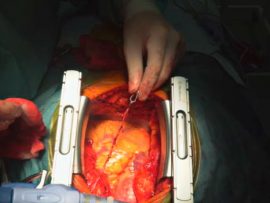Abstract Cardiopulmonary bypass (CPB) circuits can significantly sequester intravenous anesthetics. Adsorption of medications by our institution’s standard circuit (Terumo CAPIOX FX05 oxygenator; noncoated polyvinylchloride tubing) has not been described. We..
Read MoreAbstract Acute brain injury (ABI) increases morbidity and mortality in patients with veno-arterial extracorporeal membrane oxygenation (VA-ECMO). Optimal neurologic monitoring methods have not been well-explicated. We studied the use of..
Read MoreIntroduction Enhanced recovery after surgery (ERAS) is a term encompassing a set of strategies and practices aimed at reducing the surgical stress response and optimizing patient recovery through an evidence-based,..
Read MoreAbstract Background: During cardiosurgical procedures that use extracorporeal circulation (ECC), a variety of neurological complications can occur, and postoperative cognitive deficits remain an unsolved problem. Among the sources of these complications..
Read MoreAbstract Cardiopulmonary bypass (CPB) circuits can significantly sequester intravenous anesthetics. Adsorption of medications by our institution’s standard circuit (Terumo CAPIOX FX05 oxygenator; noncoated polyvinylchloride tubing) has not been described. We..
Read MoreAbstract Background Inflammatory and endothelial activation responses during extracorporeal membrane oxygenation (ECMO) support in children are poorly understood. In this study, we aimed to determine if circulating inflammatory, endothelial activation,..
Read MoreI will show you how to estimated the pulmonary artery systolic pressure (PASP) with echocardiography. Pulmonary hypertension video link here: En este video les dire como estimar la presion..
Read MoreAbstract Thrombosis in extracorporeal membrane oxygenation (ECMO) circuits remains a frequent complication. We characterize the location, extent, structure, and clinical implications of thrombi in 53 ECMO circuits from 46 pediatric patients...
Read MoreAbstract Background Many studies have reported that dexmedetomidine protects organs from ischemia/reperfusion-induced injury. However, the mechanism of this protective effect remains inconclusive. Methods Rats were randomly divided into 6 groups..
Read MorePatient with COVID 19 and thrombosis within LA as well as RA and Pulmonary embolism undergone triple embolectomy with total inflow technique by dr.Zeraatian Nejad Davani. Dr.Sam Zeraatian Nejad Davani,..
Read MoreHow to apply Edwards Mitral biologic valve in Tricuspid position in the beating heart with bicaval cannulation and total inflow technique without damaging any conduction system. Dr.Sam Zeraatian Nejad Davani,..
Read MoreAbstract Objective Metabolism management plays an essential role during cardiopulmonary bypass (CPB). There are different metabolic management devices integrated to heart–lung machines; the most commonly used and accepted metabolic target..
Read MoreAbstract Background (AKI) is common after cardiac surgery and is difficult to predict. N-terminal pro-B-type natriuretic peptide (NT-proBNP) is highly predictive for perioperative cardiovascular complications and may also predict renal..
Read MoreAbstract Objective Retrograde arterial perfusion is frequently used in minimally invasive cardiac surgery. However, there are concerns about its safety. Methods A prospective observational cohort study was conducted in a..
Read MoreAbstract Various anticoagulant properties have been associated with hydroxyethyl starch (HES). However, the mechanism remains unclear and it has not been fully considered whether these properties are beyond the dilutional..
Read MoreAbstract BACKGROUND The relicensing of aprotinin in Europe and Canada has stimulated discussions on its usefulness in paediatric cardiac surgery. OBJECTIVE To systematically evaluate the available evidence on the efficacy..
Read MoreAbstract OBJECTIVES Implanting a durable left ventricular assist device (LVAD) in a patient on extracorporeal life support (ECLS) is challenging. The goal of this study was to compare..
Read MoreAbstract The use of clinical debriefing promotes team reflexivity, aligns with Safety II principles and allows organisation leaders to engage clinicians in collaborative change. There is ample evidence of its..
Read MoreAbstract Background Suboptimal tissue perfusion and oxygenation may be the root cause of certain perioperative complications in neonates and infants having complicated aortic coarctation repair. Practical, effective, and real-time monitoring..
Read MoreAbstract Study objective To test the hypotheses that in adults having cardiac surgery with cardio-pulmonary bypass, perioperative hypotension increases the risk of delirium and atrial fibrillation during the initial five..
Read MoreAbstract The aim of the study was to evaluate the effectiveness of a new technology for the use of inhaled nitric oxide (NO) for the heart and lung protection during operations..
Read MoreAbstract Patients with bilateral high degree carotid stenosis or occlusion impose high risk for neurological complications during coronary arterial bypass surgery (CABG). Former articles have described successful CABG in patients..
Read MoreAbstract Background Cerebral autoregulation (CA) impairment is associated with neurological complications among children supported by extracorporeal membrane oxygenation (ECMO). Severe variations of arterial CO2 (PaCO2) and O2 (PaO2) tension after ECMO onset..
Read MoreAbstract Introduction: Although the management of body water balance on cardiac surgery with cardiopulmonary bypass (CPB), especially in children, is essential, little is known how body water composition changes around CPB...
Read MoreThis case reports on a 49-year-old female patient who presented to hospital with locally advanced carcinoma of the pancreatic head with jaundice, weight loss, abdominal pain and ascites already manifested...
Read MoreAbstract Background Chronic obstructive pulmonary disease, cystic fibrosis and usual interstitial pneumonia are three most common indications for lung transplantation (LuTx) in Poland. As a result of irreversible destruction of..
Read MoreAbstract Objectives Heparin resistance (HR), defined as a decrease in heparin responsiveness, can result in adverse events with prolonged duration of surgery. Although some clinical risk factors have been suggested,..
Read MoreAbstract Background: Vasoplegic syndrome (VPS) is defined as systemic hypotension due to profound vasodilatation and loss of systemic vascular resistance (SVR), despite normal or increased cardiac index, and characterized by..
Read More

















